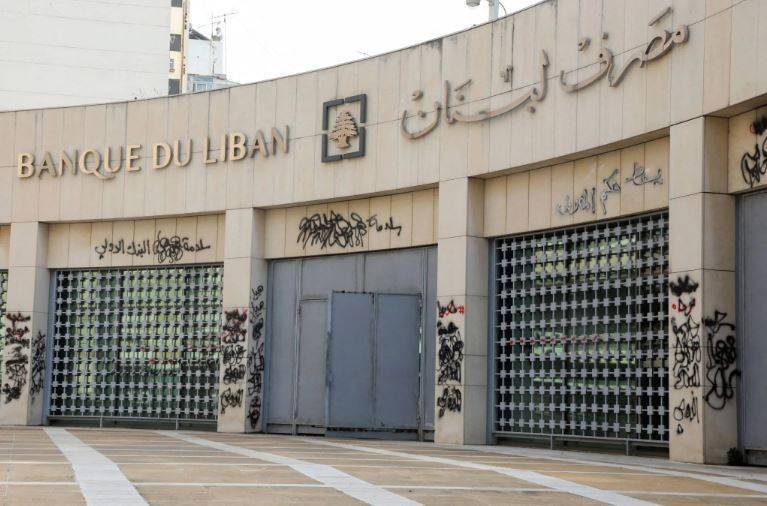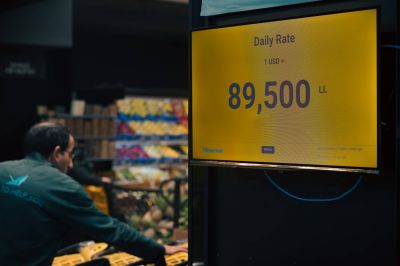
The headquarters, covered with tags, of the Banque du Liban in Beirut, March 21, 2022. (Credit: Mohamed Azakir / Reuters)
It’s 9 p.m. on Wednesday. In a shopping mall in Dbayeh, the salesmen pace up and down the clothing stores while the last customers browse for a good deal or last-minute impulse buy.
On informal apps, the parallel market exchange rate to the dollar suddenly dropped by about 15 percent. After two months on the rise — hitting a record of LL90,000 to the dollar on Wednesday afternoon —the rate dropped to just below LL80,000 shortly before midnight.
Once again, a new announcement made by Banque du Liban (BDL) was the cause of the fluctuation. Without prior notice, the central bank announced a new set of measures with unclear effects, once again taking depositors and banks by surprise, three bankers told L’Orient-Le Jour Wednesday evening.
Sayrafa almost doubled
First, BDL drastically increased the exchange rate of its own Sayrafa platform. This rate almost doubled, increasing from LL45,400 to LL70,000 on the dollar.
Amended intermittently and obscurely, the Sayrafa rate applies mainly to lira-to-dollars conversion operations that individuals and businesses can perform through their bank under BDL’s Circular No. 161.
Since it was introduced in late December 2021, Circular No. 161. allowed depositors to obtain dollars at the same subsidized rate that BDL technically provides to banks.
Since mid-January, only public sector employees have been allowed to take advantage of this sayrafa mechanism when withdrawing their salaries. This has allowed them to earn more than what they would have earned if they traded their salaries based on the parallel market rate. By trading in their meager lira salaries for subsidized sayrafa dollars, civil servants were able to put a bit more money in their pockets.
The floodgates reopen
On Wednesday night, BDL also announced the possibility for non-government employees and businesses — with the exception of those importing fuel — to exchange their lira for dollars at the subsidized Sayrafa rate. But there are conditions.
The limit on the lira-to-dollars conversions via the new LL70,000 Sayrafa rate is now set at LL1 billion per account for individuals, or $14,285 , and LL10 billion per account for companies, or $142,857.
While BDL did not specifically state it, this cap is in principle only valid for a single transaction and the duration of this measure is not specified. BDL simply stated the measure is applicable “until further notice.”
The dollar amounts that would be obtained through these conversions can be withdrawn from the bank after three business days. This new ceiling for Sayrafa withdrawal replaces the previous limit of $300 that was enforced until Wednesday but was not actually effective. BDL said it will honor all requests that meet the new conditions, beginning Thursday.
Finally, civil servants — who would rush to ATMs en masse at the beginning of each month to withdraw their salaries in dollars — will still be able to withdraw dollars at the previous LL45,400 rate, thus preserving their meager profits.
A reminder from December
The fact that BDL is working to inject dollars into the market at a rate lower than the parallel market, using its foreign currency reserves that have been dwindling since the start of the crisis — which are less than $10 billion, according to BDL’s latest bi-monthly update on Wednesday — should be reassuring.
The problem is that this new set of measures resembles the ones Central Bank Governor Riad Salameh adopted at the end of December. Salameh’s measures promised lira-to-dollar Sayrafa conversion operations without a ceiling, but were only maintained for a few days.
During this short period, many people deposited their liras into banks, in hopes of converting them to USD at the subsidized Sayrafa rate, but In the end, BDL decided to restore the previous conversion ceilings and the value of depositor’s liras remained the same
This decision, once again, came as a surprise. The parallel market exchange rate, proceeded to recover from nearly LL48,000, to over LL42,000 to a dollar between Dec. 27 and 31, only to resume its depreciation to its current low.
Fears of the banks
Bankers contacted by L’Orient-Le Jour on Wednesday evening appeared to be perplexed.
In fact, they said they learned of this measure at the same time as the depositors, who have been facing illegal restrictions on the access to their bank accounts since 2019. Banks fear BDL’s announcement will prompt customers to rush into banks in the coming days.
“We don’t know anything about the specific terms and conditions that BDL will impose to agree to give cash dollars that our customers would request,” one banker said. “All I can tell you is that this would be easier for companies, as they have better-established compliance procedures in this regard.”
On Thursday morning, the same banker said his office sent an e-mail to BDL to get clarification on the terms and conditions for individuals. He did not rule out the possibility that, like at the beginning of the year, banks would apply lower exchange limits — fewer than $1 billion for compliance reasons.
The same banking source said his clients would expect the measure not to be implemented immediately, as was the case last time.
A second banking source pointed to the banks’ ongoing strike, which began Feb. 6 to protest certain attacks on the part of the Lebanese judiciary, which they deemed unjustified.
Banks are also calling for certain changes, particularly the adoption of a capital control law that they believe is necessary for them to remain fully operational.
This position, however, is far from convincing to depositors.
While the Association of Banks in Lebanon (ABL) decided to suspend the strike this week while the majority of Lebanese collected their salaries, its general assembly is expected to decide on Friday whether its members will open their branches normally next week or continue the strike.
A third banker said he fears that unlimited exchange operations through the central bank’s Sayrafa platform would only serve as a short-term palliative.
“[Salameh] seems to be counting on the psychological effect of such a measure, but I am afraid that it will not last long, as it didn’t last time,” the same banker told L’Orient-Le Jour.
He explained that, by selling dollars at a rate lower than the parallel market, BDL is recording new losses on its balance sheet without managing to control the supply of cash lira in circulation. The amount reached nearly LL82,000 billion at the end of December, before falling back to around LL67,000 billion, when unlimited exchange transactions were allowed through Sayrafa.
Currently, LL83,000 billion are in circulation.
Side effects
Public institutions and Lebanon’s financial sector still have to share more than $72 billion in losses with depositors— according to calculations validated by the International Monetary Fund (IMF). This leads depositors and investors to avoid placing their money in the banking circuit, opting for cash transactions instead.
Other side effects of BDL’s action are already in effect: the cost of mobile phones bills — which are priced in dollars and then converted into lira at the Sayrafa rate — have already been increased.
Lebanese people can also expect to pay much more for the few hours of public electricity they have been receiving from Electricité du Liban (EDL) for the past few weeks. The upcoming bills from EDL will be calculated from dollars converted and into lira at the Sayrafa rate, which means a 20 percent increase.
Businesses were also caught off guard by the increase that was furtively made the day before in the rate of the customs dollar. This rate is used to calculate customs duties in lira from the pre-tax prices in dollars.
They no longer know what exchange rate to apply.
This article was originally published in French in L'Orient-Le Jour. Translation by Joelle El Khoury and Sahar Ghoussoub.

